The value of wood cut from 1849 to 1900 exceeded in value all of the gold produced during the same years. In fact, Michigan’s "green gold" brought in one billion dollars MORE than the California gold rush. Michigan produced more than 5.5 billion board feet of lumber. A board foot is a piece of wood that is one foot long, one foot wide and one inch thick.
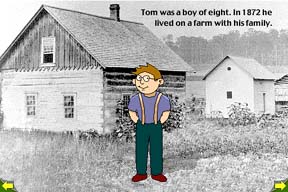
Tom Cobb was a boy of eight. In 1872, he lived on a farm with his family.
The rural population was 90% in 1820. By 1894, this had dropped to 61%. It was not until the 1920’s that the numbers of rural and urban dwellers was equal.
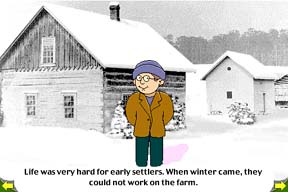
Life was very hard for early settlers. The nearest town was sixty miles away - a four day trip!
Michigan’s population in 1854 was 507,521 (Michigan Census). By 1874 it had grown to 1,334,031. Most people lived in the lower third of the Lower Peninsula.
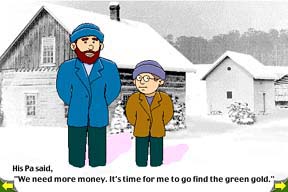
The Cobbs were entrepreneurs. The began building a mill to grind the grain produced by neighboring farmers, but ran out of money.
Cities like Battle Creek, Michigan, home of the Kellogg Corporation, started with a mill that ground grain.
When winter came, Pa said, "Son, Ma and I need more money to buy a mill stone and draft animal to finish the mill. We are going to a logging camp to find us some green gold."
Many farmers were employed by the lumber camps and the sawmills to earn cash. Just as now, farming was often not profitable.
Tom's eyes grew big with wonder. "Can I come too?"
Few children were employed in the lumber camps as the work required strength and endurance. However, children were often employed in many occupations, even at the sawmills. In the 1884 census, there were 6,416 men employed at the mills of Saginaw, with 65 women and 423 children.
Pa said, "No son, a logging camp is no place for a boy."
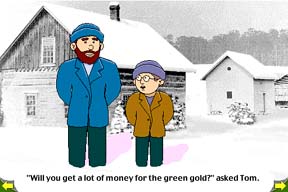
"What does green gold look like, Pa?" asked Tom.
"What will you do, Ma?"
"I will be a cook. The camps with the best cooks get the best lumbermen. They will pay me very well because I am a very good cook."
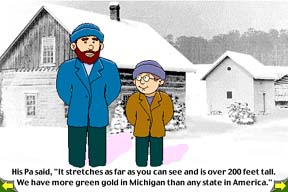
"But Pa, what does green gold look like?" Tom asked.
His Pa said, "It stretches as far as you can see and is over 200 feet tall. We have more green gold in Michigan than any state in America."
Michigan trees produced an estimated 150,000,000,000 board feet (a one inch thick board that is 12"x12") from pine timber alone. Most of these trees were cut north of the 43rd parallel. This is approximately north of a line from Muskegon to Saginaw. (Map of Michigan) Many of these trees were two to three hundred years old, and as much as five feet in diameter and 200 feet high. A good exercise for the children is to have them make a circle five feet across. Pacing off 200 feet is also an excellent way to help them visualize the size of these forests. A visit to Hartwick Pines is another way to show the students the vastness of the woods.
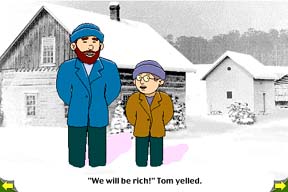
"Yippee. We will be rich!"
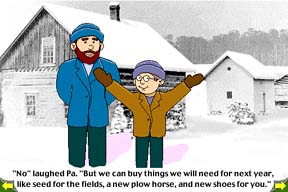
"No" laughed Pa. "But after six months of hard and dangerous work, we will earn enough to finish the mill. Then we will have a business of our own. All of our neighbors can bring their corn and wheat to us to grind into flour and corn meal.
Earning currency was a difficulty for most settlers. People traded labor and goods rather than buying them. But some items, like mill stones, where usually purchased.
Store-bought products were a rarity in rural areas. People’s needs were met by homegrown or homemade items. Imported or refined goods like coffee; sugar and certain candy were purchased at a store or trading post. These would have been considered luxuries. Very few other food items werepurchased. Prices for some items advertised in the July 4th edition of the Detroit Post daily newspaper were as follows: Business Suits were $5 to $16; Coats were $7 to $25 and brown duck pants from $.75. Bacon was 10 cents a pound. A night at the Michigan Exchange, a Detroit hotel, was $2.50.
"But what about me? I want to go too!"
Ma said, "You must stay with Grandpa and Grandma and help them take care of the animals. I know this makes you sad, but this is a sacrifice we all must make to better our lives."
The "opportunity costs" for the Cobbs to realize their dream to be mill owners were
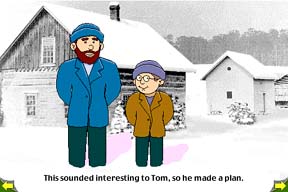
The logging camp sounded interesting to Tom, so he made a plan. One morning, when it was still dark, a wagon came to get his parents. There were a lot of men in the wagon, but no one saw Tom sneak aboard.
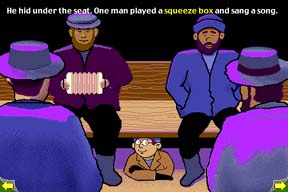
He hid under the seat. The wagon rolled all day long and into the night. One man played a squeeze box, and sang a song. Snow began to fall. Tom was cold and hungry. He fell asleep and dreamed of hills made of green gold. Then Tom began to snore!
Music played a big part in the lives of the shanty boys. Songs and words varied from camp to camp and changes were made to suit the singer. The singing (and jigging, or dancing) was the only real entertainment for the men. The versions of songs that were written down (usually many years later) are stories themselves. Students can adapt these to please themselves. (The melody was as variable as the words.) See shanty songs.
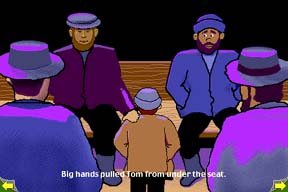
Big hands pulled Tom out from under the seat.
"Who do I have here?" said a big man.
"That's my son!" said his Pa. "Why are you here Tom?"
"I want to see the green gold, Pa"
All the men laughed. "We all want to see the green gold, son," one man said.
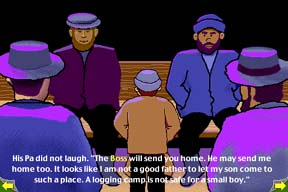
Pa and Ma did not laugh. "The Boss will send you home. He may send us home, too, " said Pa
Ma said, "This was very irresponsible, Tom. We trusted you. A logging camp is not safe for a boy." Tom climbed onto his mother's lap, shivering from the cold.
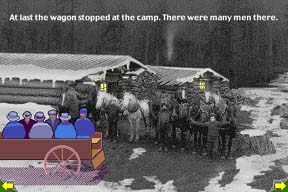
At last the wagon stopped at the camp. There were many men there. Before a camp was established, the land looker, employed by the land owner or lumber baron, came first to analyze the location and composition of the timberlands. A camp site was selected based on the land-looker’s field report and his maps. Most workers arrived at the logging camps in the late fall and worked until the snow melted in the spring.
The camp’s crews were not considered highly skilled workers, except for the blacksmith and cook. A lumber jack was usually paid at the end of the season at a rate of $20 to $30 a month, including room and board. This contrasts with the pay for a skilled sawmill worker who, in 1872, made an average of $2.30 a day. Training for a lumber camp worker was on the job. Once railroads became commonly used, a professional class of skilled lumberman developed because lumbering could be done all year round, rather than just seasonally.
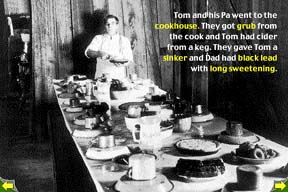
The Cobb's went to the cookhouse. The Cook greeted Ma and gave them all some grub. Tom had cider from a keg and a sinker and Ma had black lead with long sweetening.
Although not big on variety, the food in the camps was very important. Men were known to leave a camp with poor food for a camp with better than average meals. Approximately 9,000 calories a day was the usual intake and even with this amount of food. However, over-weight shanty boys and river hogs were very rare. Beans at every meal and lots of coffee were the norm. Vinegar pie was an acquired taste, but desserts were still a treat.
Ma was happy that she was to sleep on a cot in the kitchen where it was always warm and clean.
"Here, Tom, take my gloves, had and scarf. We cannot afford anything in the store. Maybe some of the men will have clothes that have shrunk to sell."
Since most winter garments were made of wool, shrinkage was a problem if clothes were soaked and improperly dried.
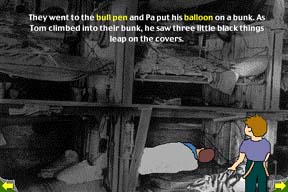
Tom and Pa went to the bull pen and Pa put his balloon on a bunk. As Tom climbed into their bunk, he saw three little black things leap on the covers.
The bunk was the only place men had to put the scant belongings they carried with them. A worker could purchase items at the company store, but they were very expensive and usually had to be bought on credit because the shanty boys seldom had cash. Trips to town were rare.
"What is that, Pa!" cried Tom.
"Oh son, bunk houses are always lousy " said his Pa.
Personal hygiene and cleanliness were not a priority with lumbermen men. In fact, people of this era took baths infrequently. Beds, clothing, and bodies in a lumber camp were infested with lice, which is where the term lousy comes from. Now, lousy refers to something that is "common, totally repulsive, miserably poor, or inferior".
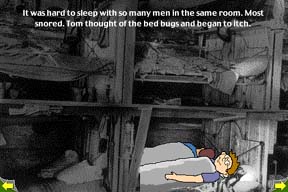
It was hard to sleep with so many men in the same room. Most snored. Tom thought of the bugs and began to itch.
The bunkhouses were crude buildings, hurriedly constructed with few, if any, windows. The heat was provided by one stove, which was usually vented out the center of the roof. Two to three men slept together in one bunk. This was a space-saver. I was probably warmer, too.
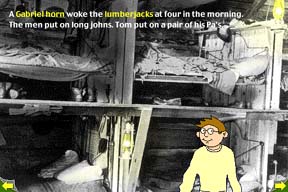
A Gabriel horn woke the lumberjacks at four in the morning. The men put on long johns, Tom put on a pair of his Pa's.
The workday was from before sun-up to sundown or beyond. The men were expected to complete 11 to 14 hour shifts, six days a week.
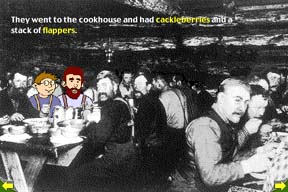
They went to the cookhouse and ate cackleberries and a stack of flappers, Ma's specialty.
The cook was one of the best paid crew members, often earning an additional $5 a month. Camps vied with each other to get the best cooks, and men often selected a camp solely on the reputation of the food.
Like most professions, logging had its own unique vocabulary. The terms were as varied as the men who used them. Many words today are derived from those log camp terms: flapjacks, log jam, lousy are but a few we still hear.

The Boss came into the cookhouse. "Where are the new men?" he roared. Tom's Pa stood up with the others. "Can you use an ax?" the Boss asked.
Until about 1870, trees were cut down with an ax and then sawed into about 16-foot lengths once on the ground. With the invention of the two man cross-cut saw which "cleaned out" the cut on the return motion by the addition of a second, shorter set of teeth. This kept the cut open and reduced the cutting time by half. The ax was used to notch the trees. The notch determined the direction the tree would fall. After the tree was down, the chopper removed the branches.
The Boss on the crew was selected by the owners for his knowledge, strength and leadership abilities. Like the cook, the Boss was better paid, and often took his pay as a percentage of the harvest.
His Pa said "yes."
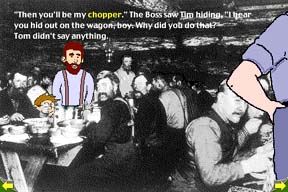
"Then you will be a chopper." The Boss saw Tom hiding behind his Pa. "I hear you hid out on the wagon, boy. Why did you do that?"
Tom looked down at his feet.
"Come on son, tell me" said the Boss.
"I came to see the green gold, sir."
The Boss looked puzzled then said, "Well, by the time you grow up, the green gold will be gone. We once thought the trees in Michigan would last two hundred years. Now with all these new inventions that make chopping and hauling logs faster, we'll be lucky to make it to the turn of the century. It is good you came to see the green gold now. But you must go home when the wagon goes back. For now, you can be our barn boy."
The Boss was unfortunately correct. The seemingly endless forests of Michigan were nearly gone by 1900.
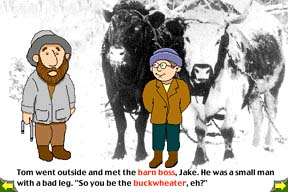
Tom went outside and met the barn boss, Jake. He was a small man with a bad leg. "So you be the buckwheater, eh?" Jake was putting the yoke on two big oxen.
Jake, like most of the men in the camps, came from elsewhere to work in the lumber industry. In 1885, 60% of the lumbering work force was foreign born. These men learned basic Englich quickly. It was easy to be injured or killed due to a simple misunderstanding.
Oxen were very strong and useful to the industry, but were also much harder to keep. It was necessary to shoe horses and oxen due to the skidding process, which required the roads to be iced. Because oxen have cloven or split hooves shoeing these animals was more difficult than for the horse. Additionally an ox has to be lifted by a sling in order to put on shoes, whereas the horse’s leg can be lifted. All work animals were well treated at the camps and usually made just five trips a day with loads.
"I'm Jake. I be the barn boss. I take care of the horses and the oxen. I do good job so they can work hard, eh?" Jake laughed. The oxen seemed taller than Jake.
"So I got me a real greenhorn. You want to see the men that do the work?" Jake asked.
"Oh, yes. But I also want to see the green gold."
"The green gold, eh? You do a good job with the oats and the water and I show you the green gold. You be lazy and you be my chickadee," laughed Jake. "Now, you take extra good care of the old plugs. They do the work of a thousand men."
The various jobs in and around the camps had a certain status, just like today. The chickadee’s job was to clear the iced roads of tree limbs, bark, AND animal feces, which made it very unpopular.
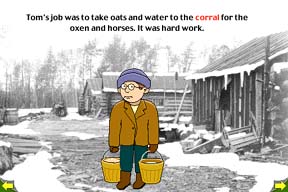
Tom's job was to take oats and water to the corral for the oxen and horses. It was hard work. At noon, Jake said, "Now we take a ride to see the green gold." They got into the cook's wagon that had food for the men. The Boss drove the wagon.
The crews were often working quite far from the camp thus it was much more efficient to bring the noon meal out to the men.
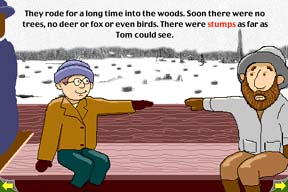
They rode for a long time into the woods. Soon there were no trees. No deer or fox or even birds. There were stumps as far as Tom could see.
"Wow, this look scary," said Tom.
"This is called cut-over land. In the old days we would pick through and cut just the best trees. Since demand is so great for lumber, it is more efficient to cut down everything and leave the scraps for the new farmers coming to Michigan. Now that the trees are gone, a farmer can move here and work the land," the Boss said.
The Federal government owned the land that comprised Michigan Territory. Land was sold through a regional land office for $1.25 and acre. This helped promote settlement in Michigan. Farm families leaving the played-out soils in New England could purchase a secure title to a virgin pioneer farm in Michigan for $100. Farmers sold off the timber to lumber barons for pennies in an effort to clear their farms for growing crops. Unfortunately, much of Michigan’s soil is poor. Most of the land was not fertile enough not support continuous farming and was soon stripped of it's fragile fertility. So, once the timber was stripped from the land, few farmers came to clear out the stumps and work the land.
Many photos of stumps indicate they were often four to six feet tall. A question to ask is ‘why did the loggers leave so much good wood?’ The answer is ‘because the trees were cut in the winter, surrounded by snow. The men were standing on several feet of snow when they cut the trees’.
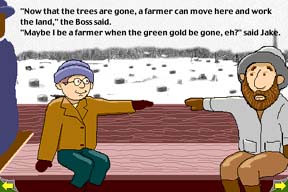
"Maybe I be a farmer when the green gold be gone, eh?" said Jake.
When they got back into the woods, the wagon came to a stop. Tom could hear the men working.
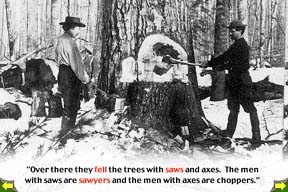
"Over there they fell the trees with saws and axes. The men with saws are sawyers and the men with axes are choppers."
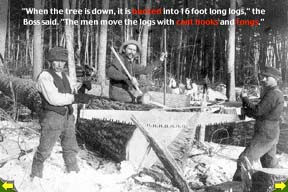
"When the tree is down, it is bucked into 16 foot long logs," the Boss said. "The men move the logs with cant hooks and tongs.
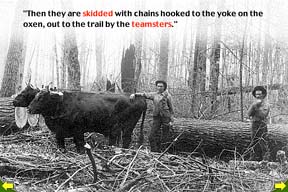
Then they are skidded with chains hooked to the yoke on the oxen, out to the trail by the teamsters."
Before the advent of the narrow gauge railroad, moving the massive logs was done only in winter. Without any form of mechanization, the only method for moving logs over land was by dragging. Logging trails were iced to make a slick surface that made the job easier. If the winter was warm, the logging season suffered.
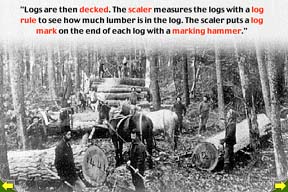
"Logs are then decked. The scaler measures the logs with a log rule to see how much lumber is in the log. The scaler puts a log mark on the end of each log with a marking hammer.
A log mark was used to indicate ownership. Thousands of log marks were used, often several by one company. These marks were very similar to brands used for cattle, although the marks were pounded into the ends of the logs, not burned.

"What's that sled with the huge wheels?"
"That's called a Big Wheel. A guy named Cyrus Overpack came out with this new invention. This card has big wheels so it can roll over stumps. We can now cut down trees much deeper into the forest without taking the time to make roads."
Cyrus Overpack of Manistee enabled cutting to continue in the snowless seasons by providing an alternative to sled transportation. The Big Wheel made iced roads unnecessary. He devised the big wheel after seeing farmers in Indiana use similar devices. His Manistee factory produced wheels in three diameters. The big wheel made him a millionaire, one of many from the lumbering era.
"So that means you can cut more trees in less time?"
"And soon we'll have a narrow gauge railway system out here that will really speed up production," said the Boss
Like the Big Wheel, the narrow gauge railroad helped to make lumbermen independent of the weather. For the short runs to the banking ground along rivers, trains could be used in place of sleds. Alternatively, the river drive could be eliminated by carrying the logs to a mainline railroad depot. Additionally, the narrow gauge railroad was quite economical. A line could be put into areas that had been considered too remote from the nearest river previously. When the area was logged out, the railway line would be removed and laid elsewhere. In 1876-77 Winfield Scott Gerrish first experimented with the narrow gauge railway in Clare County, Michigan. This first success provided to boost needed to make it a wide-spread transportation vehicle.
"Ja, do more trees we cut down, da more money de owner makes."
"More men lost their shirts in this business than have become millionaires, Jake."
Market fluctuations and bad weather were two factors that broke many people investing in timber. Other things, like fires and scarcity of reliable labor also impacted the lumberman.
"What happens then?" Tom asked.
"Well, the big wheels or sleighs haul the logs to the river. Then the logs are banked until the snow melts and makes the river swell."

"When the snow melts, the river flows faster. We push the logs into the water and let the river current take them down stream to the mills," said the Boss. "River hogs keep the logs moving and break up log jams with peaveys and pike poles. Some of them wear caulk boots."
The river crew was usually paid more than the others were because their work was very dangerous. Many of the camp legends, which were retold in stories and songs, were based on these men. Although Paul Bunyan cut down many trees and dragged many logs to the banks of the rivers, he was most "admired" for his river prowess.
"That must be fun," said Tom.
The Boss replied, "No, it might sound fun but it's dangerous. That is how Jake got hurt. He fell off and the logs crushed his leg."
"Wow! The river hogs must be wet and cold all the time. Where do they eat and sleep?" asked Tom.
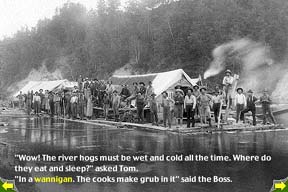
"In a wannigan. The cook makes the grub in it," said the Boss. "Sometimes the men sleep in the wannigan and other times they camp on the riverside."
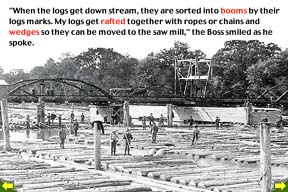
"When the logs get down stream, they are sorted into booms by their log marks. My logs get rafted together with ropes or chains and wedges so they can be moved to the saw mill," the Boss smiled as he spoke.
In the spring, the rivers were filled with logs and unhappy farmers and unscrupulous loggers dammed the rivers to prevent their use. In the early 1850’s, the Michigan courts adopted the "saw-log test of navigability". It stated that if a stream could float a log, the waterway was public. With rivers often jammed with logs, confusion as the to ownership of the logs was a real problem In 1855, the law defining the scope of the newly formed booming companies helped eliminate the confusion and made identification easier. Once a log reached the booming yards, adjacent to the mills, it was sorted by log mark into a floating pen designated for each owner.

"I know what a saw mill is! That is where the big logs are cut into planks or lumber," said Tom.
Mills were in operation during the logging season. The capacity of mills varied, but the John McGraw mill in Bay City occupied 200 acres. It contained a sawmill, salt works, dryers and other buildings and massive storage. Often called the largest in the world, the McGraw mill had more than 350 employees and cut up to 80 million board feet in a year (season.) Saw mills were usually located at the mouth of the rivers where logs were driven. The sawmill changed radically with the invention and adoption of the steam powered saw. Where formally the saws were powered by water, by the end of the 1870's nearly all mills had converted to this faster and more efficient method of sawing timber. Obviously, this investment by the mill owners made great economic sense.
Many mills in the Saginaw Valley also had salt works. The area had heavy concentrations of brine water, which was evaporated to extract salt. Evaporation process was assisted by heaters fueled by the scrap wood and sawdust left from milling. These salt works were very profitable for the owners. In Muskegon, an attempt was made to drill a well for brine water only to hit oil, causing the owner to have the useless commodity’s source capped! Both brine and oil are natural phenomena.

"That's right. Then the lumber is stacked. When it is sold, it is put on a ship or a train to go where it is needed," said the Boss. "Let's get some grub Tom."
The lumber output of the Saginaw Valley was mainly shipped to the East Coast, whose forests had been depleted by the flood of immigrants from Europe. Westward settlement of the treeless prairies was aided by lumber from the mills of Muskegon and other West Side mills. Muskegon mills also furnished most of the wood to rebuild Chicago after the devastating fire of 1871.
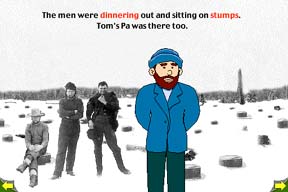
The men were dinnering out and sitting on stumps. Tom's Pa was there too.
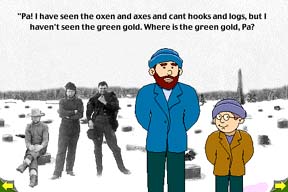
"Pa! I have seen the oxen and axes and cant hooks and logs, but I haven't seen the green gold. Where is the green gold, Pa?" Tom asked.
His Pa said, "Look over there and what do you see?"
Tom looked where his father was pointing, "A lot of trees, Pa."
"That is right! The trees are the green gold, Tom."
"What? I don't get it, Pa, how are trees gold?"
"Most of the trees out East were cut down long go, so the supply of lumber there is very scarce. But every year thousands of new people are immigrating to America. They need lumber to build houses, barns, and even mills. So the demand for lumber is high. Think about it this way. If there was only one coat in the camp store and ten men wanted it, what would happen to the coat's price?"
"It would go up. Low supply and high demand means higher prices."
"So if we have a few trees and a lot of people wanting lumber . . . "
"I've got it! Trees are as precious as gold - that's why they're called Green Gold!"
The lumber industry had a monumental effect on Michigan. The industry helped boost population so that it qualified for statehood. And the economic impact brought vast riches to people affiliated to the lumbering industry in any way. Thousands of men, and some women and children found employment in various niches of the industry. And although the decline of lumbering caused many to lose their jobs and resulted in the abandonment or decline of many communities, the automotive industry soon bloomed to fill gaps and create vast opportunities for the entrepreneurs, workers and investors and citizens of Michigan.